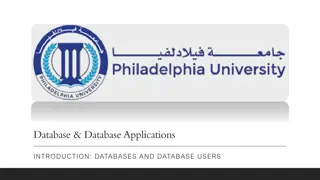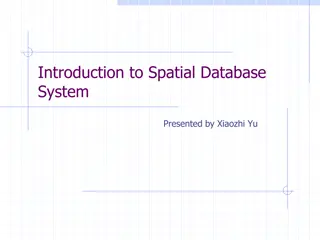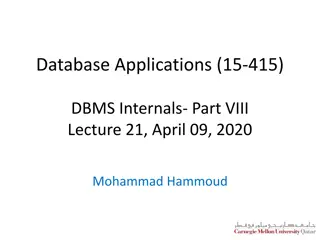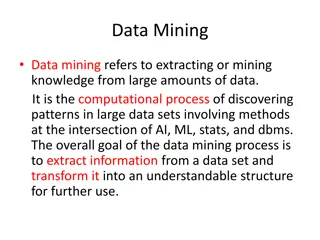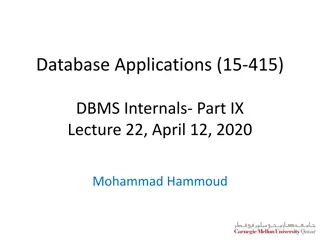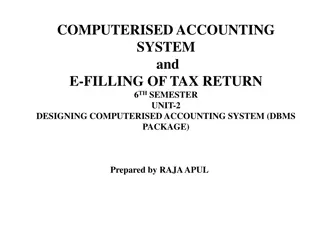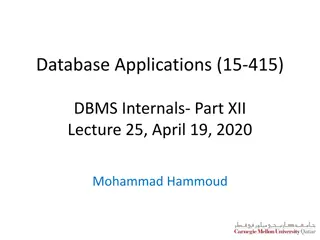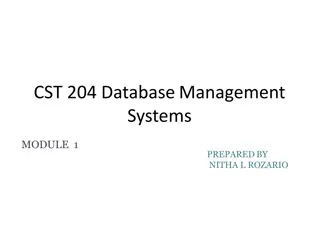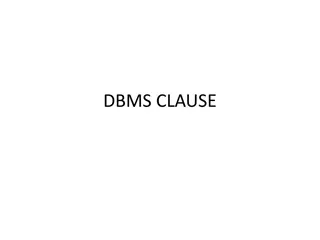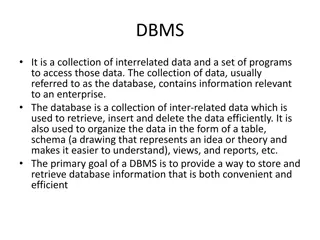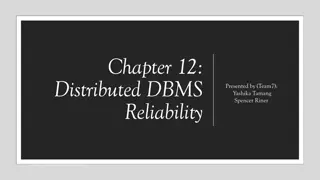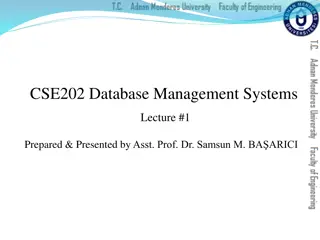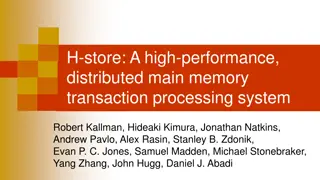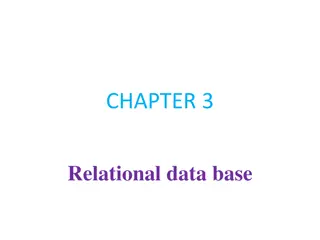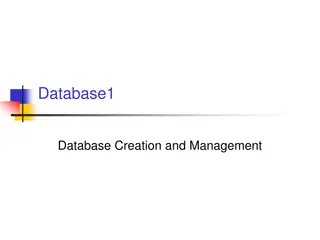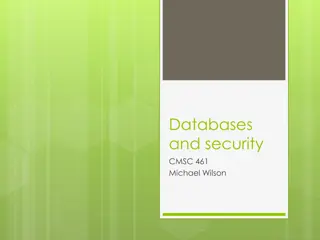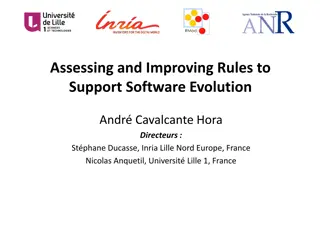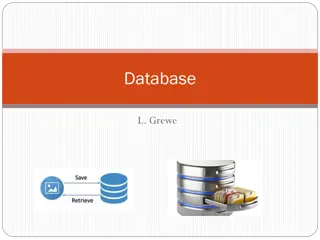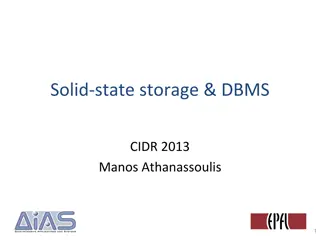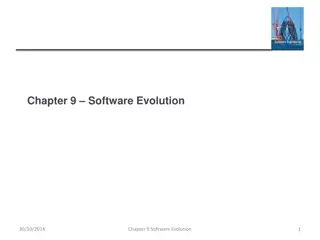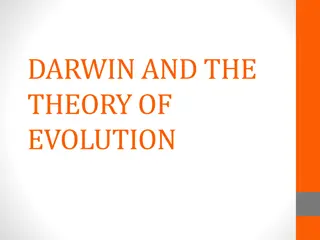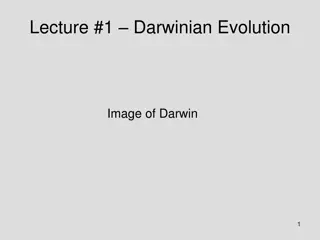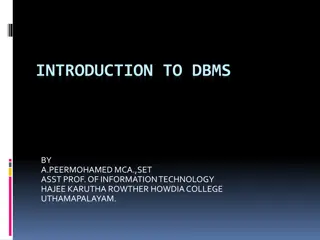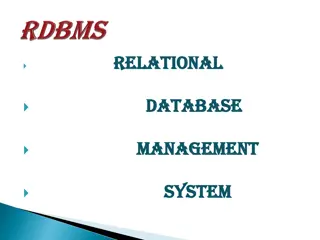Dangling Tuples
Learn about dangling tuples in DBMS, which are tuples that do not participate in a natural join, potentially indicating consistency issues in the database. Referential integrity constraints play a key role in identifying and addressing dangling tuples.
1 views • 58 slides
Understanding Databases and Database Applications
Databases are collections of related data used to store known facts with implicit meanings in a structured manner. A Database Management System (DBMS) is crucial in managing databases efficiently by defining structures, loading data, manipulating content, ensuring security, and facilitating data acc
1 views • 15 slides
Understanding Spatial Database Systems: An Overview
This presentation by Xiaozhi Yu introduces the fundamentals of spatial database systems, covering topics such as spatial data types, relationships, system architecture, modeling, and organizing underlying spaces. It delves into the importance of integrating geometry into DBMS data models, spatial in
1 views • 30 slides
Understanding Hash Join Algorithm in Database Management Systems
In this lecture, Mohammad Hammoud explores the Hash Join algorithm, a fundamental concept in DBMS query optimization. The algorithm involves partitioning and probing phases, utilizing hash functions to efficiently join relations based on a common attribute. By understanding the intricacies of Hash J
1 views • 41 slides
Introduction to CS143 Data Management Systems Course
This course, taught by Professor Junghoo John Cho, covers topics such as data management systems, SQL, RDBMS, and NoSQL databases. Students will learn to store data, interact with databases using SQL, and understand the workings of DBMS. The course objectives, structure, staff information, lecture f
1 views • 21 slides
Understanding Data Mining: Processes and Applications
Data mining involves extracting knowledge from large data sets using computational methods at the intersection of AI, ML, stats, and DBMS. It aims to discover patterns and transform data into actionable insights for various applications such as predictive modeling and anomaly detection.
0 views • 11 slides
Query Optimization in Database Management Systems
This content covers the fundamentals of query optimization in Database Management Systems (DBMS), including steps involved, required information for evaluating queries, cost-based query sub-system, and the role of various components like query parser, optimizer, plan generator, and cost estimator. I
0 views • 51 slides
Database Design Principles and Management Overview
This document presents an overview of database design principles, including structured, semi-structured, and unstructured data types. It delves into the role of Database Management Systems (DBMS) in defining, constructing, manipulating, and sharing databases effectively. It also covers various types
0 views • 47 slides
Steps to Create a Computerised Accounting System Using MS Access
This guide provides detailed steps on designing a computerised accounting system using a DBMS package, specifically MS Access. Learn how to create a database, design tables, forms, add buttons, and generate reports efficiently. Follow the step-by-step instructions to streamline your accounting proce
0 views • 12 slides
Understanding Transaction Management in DBMS
In this lecture, Mohammad Hammoud covers the key aspects of transaction management in database management systems (DBMS). Topics include locking protocols, anomaly avoidance, lock managers, and two-phase locking. The session delves into the rules, data structures, and processes involved in maintaini
1 views • 56 slides
Introduction to Database Management Systems
Understanding the fundamentals of Database Management Systems (DBMS), including data models, schema architecture, entity-relationship models, and the role of DBMS in storing, manipulating, and analyzing data efficiently. Explore the significance of database systems in managing information and ensuri
0 views • 132 slides
Understanding WHERE Clause in DBMS
The WHERE clause in a database management system (DBMS) is used to fetch filtered data based on specific criteria or patterns. Operators such as >, >=, <, <=, =, <>, BETWEEN, LIKE, and IN can be used with the WHERE clause to define filtering conditions. This article explains the usage of WHERE claus
1 views • 24 slides
Understanding Database Management Systems (DBMS)
A Database Management System (DBMS) is a crucial tool for organizing, storing, and managing data efficiently. It allows users to create, update, retrieve, and delete data effectively, ensuring data consistency and security. DBMS software like MySQL and Oracle provide interfaces for various database
0 views • 21 slides
Understanding Joins in DBMS: INNER JOIN, LEFT JOIN, and Examples
Join statements in DBMS, such as INNER JOIN and LEFT JOIN, are used to combine data from multiple tables based on a common field. INNER JOIN selects rows that satisfy a condition from both tables, while LEFT JOIN returns all rows from the left table and matching rows from the right table. Examples i
3 views • 19 slides
Microsoft Access: A Comprehensive Overview
Microsoft Access is a powerful Database Management System (DBMS) that integrates the relational Microsoft Jet Database Engine with a user-friendly graphical interface. It is a key component of the Microsoft Office suite, offering tools for database creation, data input, querying, and report generati
0 views • 18 slides
Understanding Database Deadlocks and Detection
Database Management Systems (DBMS) often face deadlocks, which are situations where transactions are waiting for each other to release data items, leading to a cycle in the wait-for graph. Deadlocks can be detected by analyzing the wait-for graph periodically. If a deadlock is detected, a victim tra
0 views • 10 slides
Distributed DBMS Reliability Concepts and Measures
Distributed DBMS reliability is crucial for ensuring continuous user request processing despite system failures. This chapter delves into fundamental definitions, fault classifications, and types of faults like hard and soft failures in distributed systems. Understanding reliability concepts helps i
0 views • 58 slides
Distributed DBMS Reliability Overview
This chapter delves into the critical aspect of reliability in distributed database management systems (DBMS). It explores the concepts, measures, types of faults, and the significance of maintaining atomicity and durability properties of transactions in ensuring system reliability. The narrative hi
0 views • 51 slides
Ancient Origins and Evolution of Data Management Systems
Explore the historical roots of human interest in data, tracing back to ancient times and primitive methods of data storage. Discover how data needs have shaped technological advancements, leading to the development of sophisticated Database Management Systems. Learn about the various types of datab
0 views • 122 slides
Understanding H-Store: A High-Performance, Distributed Main Memory Transaction Processing System
H-Store is an experimental main-memory DBMS optimized for online transaction processing (OLTP) applications. It is highly distributed and runs on a cluster of shared-nothing, main memory executor nodes. The system stores data in tables with each row corresponding to a record, ensuring atomic transac
1 views • 22 slides
Introduction to Database Systems and SQL Programming
Understanding database systems is crucial in today's digital world. Explore the basics of database systems, SQL statements, and Java Database Connectivity (JDBC) in this comprehensive overview. Learn about DBMS, SQL querying, JDBC API, and more to enhance your understanding of managing and interacti
8 views • 24 slides
Understanding Relational Databases and File-Based Systems
This chapter delves into the fundamental concepts of databases, comparing them to file-based systems, and highlighting the significance of relational databases in modern integrated AISs. It explores the difference between logical and physical views of databases, introduces key concepts such as DBMS
0 views • 70 slides
Understanding Database Management Systems and Concepts
Explore the world of databases with topics ranging from Database Creation and Management to Basic Database Terms. Learn about the significance of data, information, and metadata in decision-making processes. Discover the purpose of database systems and the role of Database Management Systems (DBMS)
0 views • 25 slides
Efficient Cross-Engine Transactions in Skeena
Skeena presents efficient and consistent cross-engine transactions, offering solutions to challenges faced by traditional database engines. By utilizing memory-optimized database engines and a multi-engine DBMS approach, Skeena addresses issues such as high costs and compatibility concerns associate
2 views • 21 slides
Understanding Joins in DBMS: Types and Operations
Joins in DBMS are binary operations that allow you to combine data from multiple tables using primary and foreign keys. There are two main types of joins: Inner Joins (Theta, Natural, EQUI) and Outer Joins (Left, Right, Full). Inner joins help merge data from tables based on specified conditions, wh
0 views • 16 slides
Evolution of Compact Star-Forming Galaxies and Quiescent Galaxies
The evolution of galaxies from compact star-forming to quiescent states involves processes such as secular evolution, gas inflows, and star formation quenching. By studying the structural relations and star formation in these galaxies, insights are gained into their transition towards quiescence. Th
0 views • 12 slides
The Scopes Monkey Trial: Clash of Cultures and Evolution Debate
Following World War I, the Scopes Monkey Trial in Tennessee marked a pivotal clash between urban and rural cultures over the teaching of evolution. The trial, prosecuted by William Jennings Bryan and defended by Clarence Darrow, resulted in teacher John Scopes being found guilty of violating the ant
0 views • 9 slides
Understanding User Permissions in Database Management Systems
Database Management Systems (DBMS) offer security measures to control user accesses and permissions. Users can be assigned specific access rights and commands. This guide explains concepts like creating users, granting privileges, managing roles, and using GRANT commands effectively in DBMS.
0 views • 12 slides
Rules and Practices for Software Evolution Support
This content focuses on the importance of rules and practices to support software evolution, addressing challenges, benefits, and impact on ecosystems. It emphasizes the need for system-specific rules, automatic extraction of conventions, and client support. The evolution of software is highlighted
0 views • 65 slides
Understanding Database Management Systems and Data Storage
Explore the world of Database Management Systems (DBMS) and learn about the evolution of data storage from flat-file to relational databases. Discover the key features of a DBMS, different database types, administration tools, SQL and NoSQL databases, CAP theory, and considerations for choosing betw
0 views • 32 slides
Challenges and Opportunities of Using Flash in Database Management Systems
Exploring the integration of flash storage in DBMS presents various challenges such as performance instability and cost, while also offering opportunities for efficient random access and write caching. Re-architecting DBMS for solid-state storage and utilizing flash as secondary storage are key cons
0 views • 12 slides
Software Evolution: Managing Change and Evolution in Organizational Systems
Software evolution is an essential process for organizations to maintain the value of their critical business assets. It involves adapting to new requirements, addressing errors, and enhancing performance. The majority of software budgets in large companies are dedicated to evolving existing systems
0 views • 61 slides
Darwin and the Theory of Evolution: A Comprehensive Overview
Darwin's Theory of Evolution encompasses the concepts of organisms changing over time and life evolving through natural selection. Influenced by scientists such as James Hutton, Jean Baptiste Lamarck, and Alfred Russel Wallace, Darwin's theory culminates in the idea of evolution by natural selection
0 views • 9 slides
Understanding Evolution: Key Concepts and Perspectives
Explore the concepts of Darwinian evolution, evidence for evolution, Darwin's theory, and the Modern Synthesis. Delve into the spiritual versus intellectual perspectives, the diversity of religious affiliations globally, and the compatibility of faith and science in understanding the natural world a
0 views • 91 slides
Understanding Database Management Systems (DBMS): A Comprehensive Overview
This comprehensive overview of Database Management Systems (DBMS) covers the definition, environment, advantages, limitations, and characteristics of data in a database. It delves into the hardware and software components, user roles, and benefits of using a DBMS. The content highlights the control
0 views • 25 slides
Unveiling the Cosmic Evolution: A Journey Through Galaxies, Stars, and Empty Space
Delve into the intricate story of the universe's evolution from its hot dense origins to the vast cosmic web of stars and galaxies. Explore questions on stellar birth rates, interstellar medium influences, and the role of dark energy. Follow the journey of three students working on the Cosmic Evolut
0 views • 30 slides
Understanding Evolution: Key Concepts and Perspectives
Explore the key concepts of Darwinian evolution, including evidence for evolution, Darwin's theory, and the Modern Synthesis. Reflect on the relationship between spiritual and intellectual perspectives, emphasizing that different ways of thinking can complement each other. Discover the diversity in
0 views • 91 slides
Visualizing Ontology Evolution for Improved Knowledge Management
Ontologies are dynamic entities that evolve over time, impacting semantically-enabled applications and knowledge acquisition. This work focuses on identifying desired functionalities for ontology evolution systems, highlighting the steps involved in ontology evolution, and emphasizing the importance
0 views • 16 slides
Evolution of Indo-European Languages through Phylogeny Estimation
Explore the evolution of Indo-European languages through phylogeny estimation under a model of linguistic character evolution. Follow the Computational Historical Linguistics Project's collaboration that began in 1994, leading to the development of methods and studies on homoplasy-free evolution and
0 views • 61 slides
Evolution of Database Management Systems
The evolution of Database Management Systems (DBMS) began with file systems and punched cards in the 1950s, followed by hierarchical and network models in the 1960s and 1970s. The 1980s introduced relational databases like Ingres, Oracle, DB2, and Sybase. The 1990s saw the rise of object-oriented an
0 views • 31 slides

